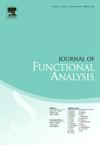切片Wasserstein空间的几何与解析性质
IF 1.6
2区 数学
Q1 MATHEMATICS
引用次数: 0
摘要
切片Wasserstein度量通过取度量与直线投影之间的Wasserstein距离的平均值来比较Rd上的概率度量。距离在统计学和机器学习中有广泛的应用,因为它比Wasserstein距离更容易在高维上进行近似和计算。虽然Wasserstein度规的几何形状已经被很好地理解,并导致了重要的进展,但对切片Wasserstein (SW)度规的几何形状和度量性质知之甚少。在这里,我们表明,当考虑的度量是“好的”(例如,由勒贝格度量的正倍数上下限定)时,SW度量可与(齐次)负索博列夫范数H˙−(d+1)/2相比较。另一方面,当所考虑的测度在无限移动度规中接近于离散测度时,它们之间的SW度规接近于Wasserstein度规的倍数。我们描述了SW空间的切空间,并证明了空间中曲线的速度可以用二次形式来描述,但SW空间不是长度空间。我们建立了度量之间曲线的最小长度- SW长度给出的度量的一些性质。最后,我们强调了这些特性对SW度量中梯度流的影响。本文章由计算机程序翻译,如有差异,请以英文原文为准。
Geometry and analytic properties of the sliced Wasserstein space
The sliced Wasserstein metric compares probability measures on by taking averages of the Wasserstein distances between projections of the measures to lines. The distance has found a range of applications in statistics and machine learning, as it is easier to approximate and compute in high dimensions than the Wasserstein distance. While the geometry of the Wasserstein metric is quite well understood, and has led to important advances, very little is known about the geometry and metric properties of the sliced Wasserstein (SW) metric. Here we show that when the measures considered are “nice” (e.g. bounded above and below by positive multiples of the Lebesgue measure) then the SW metric is comparable to the (homogeneous) negative Sobolev norm . On the other hand when the measures considered are close in the infinity transportation metric to a discrete measure, then the SW metric between them is close to a multiple of the Wasserstein metric. We characterize the tangent space of the SW space, and show that the speed of curves in the space can be described by a quadratic form, but that the SW space is not a length space. We establish a number of properties of the metric given by the minimal length of curves between measures – the SW length. Finally we highlight the consequences of these properties on the gradient flows in the SW metric.
求助全文
通过发布文献求助,成功后即可免费获取论文全文。
去求助
来源期刊
CiteScore
3.20
自引率
5.90%
发文量
271
审稿时长
7.5 months
期刊介绍:
The Journal of Functional Analysis presents original research papers in all scientific disciplines in which modern functional analysis plays a basic role. Articles by scientists in a variety of interdisciplinary areas are published.
Research Areas Include:
• Significant applications of functional analysis, including those to other areas of mathematics
• New developments in functional analysis
• Contributions to important problems in and challenges to functional analysis

 求助内容:
求助内容: 应助结果提醒方式:
应助结果提醒方式:


